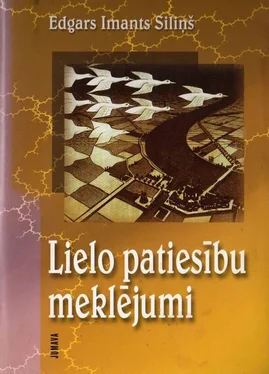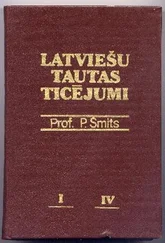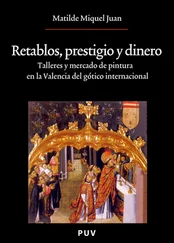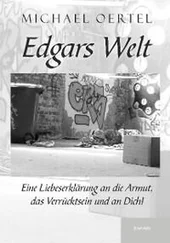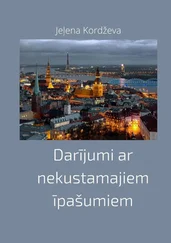207. Yam P. Exploiting Zero—point Ene>gy. — Scientific American, Dec. 1997, p. 54.
208. Zavadska J. Vārda filozofiski estētiskā Junkcija. Konfūcija un Dtuandzi mācības. —Grāmata, 1992, nr. 5/6, 67. lpp.
209. *Zāles ēna. Spāres ēna. Japāņu haiku poētiskās fotogrāfijas. G. Eglītes tulkojums un komentāri. — R.: Liesma, 1986.
210. *Zimmer H. R. Philosophies of India. — New York, 1954.
211. *3aBaflCKaa E. Boctok hu 3;in:i/ļc.— Mockbj: lIuyK:i, 1970.
The book «Search for the Great Truths» by Edgar Silinsh presents a collection of philosophical essays on the history of paradigms and ideas.
The leitmotif of these essays is the principle of complementarity, contained in the postulate «A Great Truth is a truth whose opposite is also a Great Truth», or «Contraria sunt complementa», i.e. «opposites complement each other».
The complementarity principle was formulated by the Danish physicist and thinker Niels Bohr in 1927 and has since become one of the basie postulates of 20-th century science. However, the roots of this principle may be found already in the ancient Chinese Tao philosophy of opposites, visualised in the yang-jin symbol.
Accordingly, the essays reflect the history of ideas and paradigms in the search for the Great Truths from times as carly as the ancient Chinese Tao philosophy and Zen-Buddhism up to the most modern fields of science of our days, such as quantum physics, synergetics, chaos theory, fractal geometry, cosmology and other integral spheres of knowledge.
The essays represent an attempt to follow up along the time verticalthe changes and continuity of paradigm opposites and disclose the archetypical struetures in these changes, as well as the unvarying time-independent elements.
The second importam aspect of the studies pursued in the present essays is to unveil the synchronous appearance inside the same time horizontal of ideas and paradigms characteristic of a certain period in various spheres of human spiritual activities, such as science, humanities, myths and religions of various peoples, as well as various branehes of the fine arts — literature, painting, music, architecture, both in East and West. The author strives to detect the structural isomorphism, the inner similarity of ideas and paradigms, which syncretically form a unified cultur- al stratum of a certain period.
Thus a peculiar metaphorical «Indra's mesh» is shovvn to be formed by these verticals and horizontāls of time, uniting the total cultural inhcritance of Humanity in time and space.
The essays show in their course along the variegated paths of the search for the truths that it is necessary to apply the whole vast range of human thought and ways of cognising the World, in order to arrive at the Great Truths. The capacity of ration- al thinking has to be complemented by intuitive and irrational components, visually figurative thinking, based on the logic of metaphors has to be added to the logically analytical mode of Man's thought. Traditional reduetionism has to be combined with a holistic approach to the World ouilook; paradoxical logic has to be added to formai logic in the search for new paradigms. Or, speaking in the more general context of the history of culture — the traditional Western rationalism requires an addition of its opposite — namely, a holistic approach to and understanding of the World.
The essays demonstrate, how the Nevvtonian determinacy which had reigned in the West up to the end of the 19-th century was complemented by its opposite — indeterminacy (the uncertainty principle), and how this pair of opposites constitutes the basis of modern physics and of other natūrai sciences. Another philosophical pair of opposites in the Great Truths — the categories of necessity and chance is treated in terms of the modern theory of synergetics, as well as in connection with the prob- lem of Fate and free will and their role in human life.
Another pair of opposites, that of chaos and orderzce. of fundamental importance in the dynamics of complex systems, in the theory of chaos and in fractal geometry. It is shown that only open systems, both in animate and inanimate Nature, as well as in human society, are adaptive, self-organising and capable of development.
This self-organising evolution takes place under coaditions of limited or deter- minate chaos. It manifests itself in biological morphogenesis, as well as in creative processes of human consciousness. This approach is applied, in particular in the description of the World cosmological evolution scenario, starting from the Big Bang (ca. 15 billion years ago), further in the treatment of the Earth's chemical and biological evolution, up to the unique place of homo sapieris in this evolution.
Particular stress is laid in the essays on the assertion that the science of our days has come to the conviction and proofs of the existence of a non-material, spiritual world, of a sovereign existence of both the spiritual and material worlds, both being mutually complementary opposing halves of the Great Truths.
It is also shown in the essays, that acceptance of only half of the Great Truths leads such «only truths» into erroneous blind alleys, into the trap of the «only right» belief.
Such «only truths», without a complementing opposite, is onIy a half-truth, which provides a fertile ground for limited dogmatism, sectarianism, fanaticism and totali- tarian ideology. The preachers of only truths and militant transformers of the world have brought the world to the most fatal and most tragic cataclysms, to manifold reli- gious wars, to the monsters of 20-th century totalitarianism — the horrors of nazism and communism, to the empires of evil, which have taken millions of human lives.
The book contains 92 essays, all united by the leitmotif of search for the Great Truths. Each essay is self-contained and may be read independently of the others, which accounts for and explains certain repetitions occurring in them and reliev- ing the reader from looking into previous chapters.
The book producēs the result of seven years of f creative work and is based on extensive studies of various literature, partly quoted over two hundred references.
The book represents the subjective views of the authors on the World and the happenings therein, based on experience gained in the course of quite a number of decades in scientific research and in studies in the philosophy of science.
The book is addressed to a wide circle of readers interested in modern fundamental philosophical problems about Nature and the human Spirit.
Prof. J. Eiduss
Autora ģimene izsaka pateicību visiem,
kas piedalījās grāmatas tapšanā,
un it īpaši:
LZA Fizikālās enerģētikas institūta Organisko cietvielu fizikas un molekulārās elektronikas laboratorijas kolektīvam,
Latvijas Zinātņu akadēmijas vadībai,
Dr. hab. phys., Dr. h. c. chem. Jāzepam Eidusam,
Dr. Philol. Gunai Eglītei,
Dr. habil. phil. Maijai Kūlei,
Dr. phys. Lidijai Taurei,
Rūtai Vilītei,
Sigitai Kušnerei.
APGĀDA
JUMAVA
REALIZĀCIJAS DAĻAS ADRESE:
Rīgā, Jēzusbaznīcas ielā 7/9, tālr. 7221970
Izdevējs — apgāds «Jumava», Dzirnavu iela 73, Rīgā LV 1011. Reģ. apl. nr. 2 - 1012. Iespiests a/s «Preses nams» tipogrāfija, Balasta dambi 3, Rigā LV 1081. Iesiets a/s «Paraugtipogrāfija» Puškina ielā 12, LV 1050.
[1] teksta kvadrātiekavās norādīta publikācijas vieta izmantotās literatūras sarakstā. — Re/l.
Читать дальше
